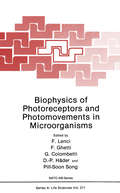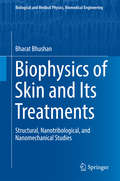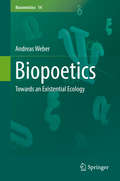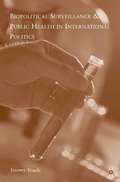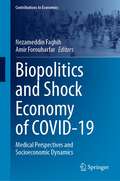- Table View
- List View
Biophysics of Photoreceptors and Photomovements in Microorganisms (Nato Science Series A: #211)
by F. Lenci Francesco Ghetti Giuliano Colombetti D. P. Häder Pill-Soon SongThis volume contains the lectures given at the NATO Advanced Study Institute on "Biophysics of Photoreceptors and Photomovements in Microorganisms" held in Tir renia (Pisa), Italy, in September 1990. The Institute was sponsored and mainly funded by the Scientific Affairs Division of NATO; the Physical Science Committee and the Institute of Biophysics of National Research Council of Italy also supported the School and substantially contributed to its success. It is our pleasant duty to thank these institu tions. Scientists from very different backgrounds contributed to the understanding of this fast developing field of research, which has seen considerable progress during the last years. The areas of expertise ranged from behavioral sciences, supported by sophi sticated techniques such as image analysis or laser light scattering, to spectroscopy, ap plied, in different time domains, to the study of the primary photoreactions, to electro physiology, biochemistry or molecular biology, with the aim of analyzing the various steps of the transduction chains and how they control the motor apparatus of the cells. The organisms studied covered a wide range, from bacteria to algae, fungi and other eukaryotes. Thus, the ASI represented a successful opportunity for carrying on and imple menting an interdisciplinary approach to the study of the biophysical basis of photore ception and photosensory transduction in aneural organisms, with special attention to the basic phenomena and the underlying molecular events. We hope that this book has caught the spirit in which the ASI was conceived.
The Biophysics of Photosynthesis (Biophysics for the Life Sciences #11)
by John Golbeck Art EstThe volume is intended as an introduction to the physical principles governing the main processes that occur in photosynthesis, with emphasis on the light reactions and electron transport chain. A unique feature of the photosynthetic apparatus is the fact that the molecular structures are known in detail for essentially all of its major components. The availability of this data has allowed their functions to be probed at a very fundamental level to discover the design principles that have guided evolution. Other volumes on photosynthesis have tended to focus on single components or on a specific set of biophysical techniques, and the authors’ goal is to provide new researchers with an introduction to the overall field of photosynthesis.The book is divided into sections, each dealing with one of the main physical processes in photosynthetic energy conversion. Each section has several chapters each describing the role that a basic physical property, such as charge or spin, plays in governing the process being discussed. The chapters proceed in an orderly fashion from a quantum mechanical description of early processes on an ultrafast timescale to a classical treatment of electron transfer and catalysis on a biochemical timescale culminating in evolutionary principles on a geological timescale.
Biophysics of Skin and Its Treatments: Structural, Nanotribological, and Nanomechanical Studies (Biological and Medical Physics, Biomedical Engineering)
by Bharat BhushanThis book provides a comprehensive overview of the structural, nanotribological and nanomechanical properties of skin with and without cream treatment as a function of operating environment. The biophysics of skin as the outer layer covering human or animal body is discussed as a complex biological structure. Skin cream is used to improve skin health and create a smooth, soft, and flexible surface with moist perception by altering the surface roughness, friction, adhesion, elastic modulus, and surface charge of the skin surface.
Biophysics of the Failing Heart: Physics and Biology of Heart Muscle (Biological and Medical Physics, Biomedical Engineering)
by R. John Solaro and Jil C. TardiffSubjects in the monograph “Biophysics of the Failing Heart” include state of the art chapters considering major biophysical mechanisms for why hearts responding to acquired or inherited stressors enter into maladaptive processes eventually leading to an inability of the heart to respond efficiently to hemodynamic loads especially during exercise. The chapters describe biophysical techniques that have been applied to determine the triggers for the heart failure process as well as the mechanisms for sustaining the disorders. These techniques include measurements of active and passive mechanical properties and hemodynamics at levels of organization ranging from molecules to hearts beating in situ. Biophysical concepts and approaches are also applied to determination of signaling and signal transduction, energetics, ionic currents, transport processes, electro-chemical and chemo-mechanical coupling. By its emphasis on biophysical aspects of a prevalent clinical condition, the monograph is unique in its perspective and focus. The breadth of information in the chapters all in one place will be of value to clinicians and researchers at all levels. Modern research approaches and clinical understanding of heart failure demands integration of multiple aspects of the disorders. In most cases, combinations of clinician scientists and researchers author the chapters. A main benefit of the book is couched in its didactic approach together with its emphasis on how biophysical concepts and techniques aid in diagnosis and development of new therapies.
Biophysics of the Pancreatic β-Cell (Advances in Experimental Medicine and Biology #211)
by Illani Atwater Eduardo Rojas Bernat SoriaPancreatic a-cell biophysics has undergone a veritable informa tion explosion in the past two years. Single channel and macroscopic currents have become easily accessible following the introduction of the patch clamp technique. In addition to this new approach, further development of techniques for optical measurements, ion-sensitive microelectrodes, permeabilized cells and mathematical modelling have recently added to the now classical techniques of membrane potential recording and tracer flux measurement. The International Workshop on Biophysics of the Pancreatic a-Cell held in Alicante (Spain) on Sep tember 30 - October 1, 1985, has now given us the opportunity to share experiences with these new techniques applied to the a-cell. Further more this was the first occasion for most of the groups doing patch clamp studies of the a-cell to decide on appropriate nomenclature and to debate the different characteristics of the a-cell ionic channels. To make this information available to the larger scientific community a record of the meeting has been assembled in this book. It is a collection of research papers by leading scientists at the meet ing working on biophysical, biochemical and physiological aspects. of secretion. We grouped their contributions in seven sections, includ ing new experimental approaches, K-channels, Ca-channels, role of ionic channels, intracellular ionized calcium, neural regulation and mechanisms of insulin release. Each section gives an account of the state of the problem at the time of the meeting, and the subjects are analyzed from the different perspectives of the various contributors.
Biophysik der Ernährung: Eine Einführung
by Thomas A. VilgisVerstehen Sie die unzähligen, widersprüchlichen Ernährungsempfehlungen nicht mehr? Können Sie beim Cholesterin nur ganz schwer zwischen Gut und Böse unterscheiden? Verstehen Sie nicht, warum 12 Nüsse pro Tag gut für Ihr Herz und Kreislauf sein sollen? Sind Sie hin- und hergerissen zwischen verschiedenen Ernährungsregeln und Ernährungsformen, die täglich auf Sie hereinprasseln, und verzweifeln am Begriff „gesunde Ernährung“? Oder sind Sie beruflich, z. B. als Berater oder Fitnesscoach, mit Fragen rund um Ernährung konfrontiert und möchten sich die naturwissenschaftlichen Grundlagen aneignen? Der Autor Thomas Vilgis rät, dabei erst einmal gelassen zu bleiben und sachlich über alle Mutmaßungen, Vermutungen, Versprechen, Orientierungsvorschläge nachzudenken.Das Buch führt Sie abseits ausgetretener Pfade und mit naturwissenschaftlicher, nüchterner Sicht an grundsätzliche Fragen der Ernährung heran. Ausgehend von der Ernährungsgeschichte des Homo sapiens begleitet Sie der Autor in das grundlegende Zusammenspiel zwischen Proteinen, Fetten und Kohlenhydraten, was sie im Körper bewirken, wie sie verdaut werden und welche Rolle sie wirklich spielen. So zeigt sich rasch, wie wenig sich hinter manchen zweifelhaften Aussagen verbirgt. Mit dem Anspruch einer ideologiefreien, molekularen Sicht auf die Ernährung gelingt es, auf verständliche und unterhaltsame Weise so manche fragwürdige Empfehlung zur Ernährung zu relativieren und zu entlarven.
Biophysik der Ernährung: Eine Einführung für Studierende, Fachkräfte und Quereinsteiger
by Thomas A. VilgisVerstehen Sie die unzähligen, widersprüchlichen Ernährungsempfehlungen nicht mehr? Können Sie beim Cholesterin nur ganz schwer zwischen Gut und Böse unterscheiden? Sind Sie hin- und hergerissen zwischen verschiedenen Ernährungsregeln und Ernährungsformen, die täglich auf Sie hereinprasseln, und verzweifeln am Begriff „gesunde Ernährung“? Oder sind Sie beruflich, z. B. als Berater oder Fitnesscoach, mit Fragen zum Thema Ernährung konfrontiert und möchten sich die naturwissenschaftlichen Grundlagen aneignen? Der Autor Thomas Vilgis rät, dabei erst einmal gelassen zu bleiben und sachlich über alle Mutmaßungen, Vermutungen, Versprechen und Orientierungsvorschläge nachzudenken.Dieses Buch führt Sie abseits ausgetretener Pfade und mit naturwissenschaftlicher, nüchterner Sicht an grundsätzliche Fragen der Ernährung heran. Ausgehend von der Ernährungsgeschichte des Homo sapiens begleitet Sie der Autor in das grundlegende Zusammenspiel zwischen Proteinen, Fetten und Kohlenhydraten, was sie im Körper bewirken, wie sie verdaut werden und welche Rolle sie wirklich spielen. Unterstützend finden Sie in der zweiten Auflage verschiedene abrufbare Videos, in denen komplexe Zusammenhänge anschaulich erklärt werden. So zeigt sich rasch, wie wenig sich hinter manchen zweifelhaften Aussagen verbirgt. Mit dem Anspruch einer naturwissenschaftlichen und molekularen Sicht auf die Ernährung gelingt es, auf verständliche und unterhaltsame Weise so manche fragwürdige Empfehlung zur Ernährung zu relativieren und einzuordnen.
Bioplastics for Sustainable Development
by Mohammed Kuddus RoohiThis book provides the latest information on bioplastics and biodegradable plastics. The initial chapters introduce readers to the various sources and substrates for the synthesis of bioplastics and biodegradable plastics, and explain their general structure, physio-chemical properties and classification.In turn, the book discusses innovative methods for the production of bioplastics at the industrial level and for the microbial production of bioplastics. It highlights the processes that are involved in the conversion of agro-industrial waste into bioplastics, while also summarizing the mechanisms of biodegradation in bioplastics.The book addresses a range of biotechnological applications of bioplastics such as in agriculture, food packaging and pharmaceutical industry, as well as biomedical applications.
Biopoetics: Towards an Existential Ecology (Biosemiotics #14)
by Andreas WeberMeaning, feeling and expression – the experience of inwardness – matter most in human existence. The perspective of biopoetics shows that this experience is shared by all organisms. Being alive means to exist through relations that have existential concern, and to express these dimensions through the body and its gestures. All life takes place within one poetic space which is shared between all beings and which is accessible through subjective sensual experience. We take part in this through our empirical subjectivity, which arises from the experiences and needs of living beings, and which makes them open to access and sharing in a poetic objectivity. Biopoetics breaks free from the causal-mechanic paradigm which made biology unable to account for mind and meaning. Biology becomes a science of expression, connection and subjectivity which can understand all organisms including humans as feeling agents in a shared ecology of meaningful relations, embedded in a symbolical and material metabolism of the biosphere.
Biopolitical Surveillance and Public Health in International Politics
by J. YoudeUsing historical and contemporary case studies, Youde traces the shifting balance between surveillance and global public good provision and suggests that a human rights-based strategy offers a stable compromise.
Biopolitics and Shock Economy of COVID-19: Medical Perspectives and Socioeconomic Dynamics (Contributions to Economics)
by Nezameddin Faghih Amir ForouharfarThis edited volume discusses the biopolitics and shock economy of COVID-19, emphasizing medical perspectives and the socioeconomic dynamics of the pandemic and the ensuing institutional responses. Written by an international, multidisciplinary group of academic and professional experts, chapters embrace a wide range of topics such as: medical perspectives on COVID-19; application of geospatial technology; infectivity, immunogenicity, and disease as important factors for adoption of relevant biopolitical measures; shock economy; COVID-19-induced transaction costs; social support and resilience of inhabitants of marginalized areas; business resilience factors; entrepreneurship; and digital transformation. Jointly addressing global examples of biopolitical governance and overarching macroeconomic effects of the pandemic, this volume will be of interest to academics across disciplines as well as policymakers and practitioners on the ground.
Biopolymere und Biomechanik von Bindegewebssystemen: 7. wissenschaftliche Konferenz der Gesellschaft Deutscher Naturforscher und Ärzte
by C. Hartung H. ZeidlerBiopolymers for Medical Applications
by Juan M. Ruso Paula V. MessinaThis book presents an experimental and computational account of the applications of biopolymers in the field of medicine. Biopolymers are macromolecules produced by living systems, such as proteins, polypeptides, nucleic acids, and polysaccharides. Their advantages over polymers produced using synthetic chemistry include: diversity, abundance, relatively low cost, and sustainability. This book explains techniques for the production of different biodevices, such as scaffolds, hydrogels, functional nanoparticles, microcapsules, and nanocapsules. Furthermore, developments in nanodrug delivery, gene therapy, and tissue engineering are described.
Biopolymers for Medical Applications
by Juan M. Ruso Paula V. MessinaThis book presents an experimental and computational account of the applications of biopolymers in the field of medicine. Biopolymers are macromolecules produced by living systems, such as proteins, polypeptides, nucleic acids, and polysaccharides. Their advantages over polymers produced using synthetic chemistry include: diversity, abundance, relatively low cost, and sustainability. This book explains techniques for the production of different biodevices, such as scaffolds, hydrogels, functional nanoparticles, microcapsules, and nanocapsules. Furthermore, developments in nanodrug delivery, gene therapy, and tissue engineering are described.
Biopotential Readout Circuits for Portable Acquisition Systems (Analog Circuits and Signal Processing)
by Refet Firat Yazicioglu Chris van Hoof Robert PuersBiopotential Readout Circuits for Portable Acquisition Systems describes one of the main building blocks of such miniaturized biomedical signal acquisition systems. The focus of this book is on the implementation of low-power and high-performance integrated circuit building blocks that can be used to extract biopotential signals from conventional biopotential electrodes. New instrumentation amplifier architectures are introduced and their design is described in detail. These amplifiers are used to implement complete acquisition demonstrator systems that are a stepping stone towards practical miniaturized and low-power systems.
Biopreparedness and Public Health: Exploring Synergies (NATO Science for Peace and Security Series A: Chemistry and Biology)
by Iris Hunger Vladan Radosavljevic Goran Belojevic Lisa D. RotzThe terrorist use of diseases as bioweapons has been one of the major security concerns in recent years, particularly after the anthrax letter attacks in the USA in 2001. This uncertain threat of intentional outbreaks of diseases exists side by side with the constantly changing very real threat from diseases, epidemics and pandemics as recently illustrated by the H1N1 influenza pandemic, SARS, and H5N1 bird influenza events. This publication contains case studies on the public health planning for (un)usual disease outbreaks for 11 large and small countries with a focus on South Eastern Europe. In many countries, military entities traditionally play an important role in emergency response to disease outbreaks. In smaller countries, very little exists, however, in terms of specific biopreparedness efforts (in both the military and civilian area), which is at least partly due to a relatively low bioterrorism threat perception, and serious resource constraints. The uncertainty associated with the bioterrorism threat makes public health preparedness planning for such events politically and financially very difficult. The similarity of responding to bioterrorism events and natural disease outbreaks from a public health point of view suggests the merit of looking at biopreparedness as a part of overall health emergency planning, not as a separate effort.
Bioprocess and Analytics Development for Virus-based Advanced Therapeutics and Medicinal Products (ATMPs)
by Saurabh Gautam Abhilash I. Chiramel Roland PachThis book reviews the knowledge, methods and available techniques in the rapidly advancing field of virus based vaccines and gene therapeutics. It also highlights new innovative tools and interdisciplinary techniques for bioprocess development and analytics of viruses and viral vectors. As such, it provides a timely and highly relevant resource, since current advances in pharmaceutical research have seen the rise of vaccines and advanced therapeutics and medicinal products (ATMPs), that rely on the power of viruses. However, developing bioprocesses and analytics required to create this often called “magic bullet” (i.e. gene therapy) remains an extremely challenging and costly task. This book offers strategies for overcoming hurdles and difficulties within in all the necessary steps of viral vector development - from scalability to purification methods and quality control. The book is intended for researchers working in academia or industry, as well as graduate students pursuing a career in virology.
Bioprocess Engineering: Downstream Processing
by Pau Loke Show Chien Wei Ooi Tau Chuan LingBioprocess Engineering: Downstream Processing is the first book to present the principles of bioprocess engineering, focusing on downstream bioprocessing. It aims to provide the latest bioprocess technology and explain process analysis from an engineering point of view, using worked examples related to biological systems. This book introduces the commonly used technologies for downstream processing of biobased products. The covered topics include centrifugation, filtration, membrane separation, reverse osmosis, chromatography, biosorption, liquid-liquid separation, and drying. The basic principles and mechanism of separation are covered in each of the topics, wherein the engineering concept and design are emphasized. This book is aimed at bioprocess engineers and professionals who wish to perform downstream processing for their feedstock, as well as students.
Bioprocess Engineering: Downstream Processing
by Pau Loke Show Chien Wei Ooi Tau Chuan LingBioprocess Engineering: Downstream Processing is the first book to present the principles of bioprocess engineering, focusing on downstream bioprocessing. It aims to provide the latest bioprocess technology and explain process analysis from an engineering point of view, using worked examples related to biological systems. This book introduces the commonly used technologies for downstream processing of biobased products. The covered topics include centrifugation, filtration, membrane separation, reverse osmosis, chromatography, biosorption, liquid-liquid separation, and drying. The basic principles and mechanism of separation are covered in each of the topics, wherein the engineering concept and design are emphasized. This book is aimed at bioprocess engineers and professionals who wish to perform downstream processing for their feedstock, as well as students.
Bioprocess Engineering for a Green Environment
by V. SivasubramanianBioprocess Engineering for a Green Environment examines numerous bioprocesses that are crucial to our day-to-day life, specifically the major issues surrounding the production of energy relating to biofuels and waste management. The nuance of this discussion is reflected by the text’s chapter breakdown, providing the reader with a fulsome investigation of the energy sector; the importance of third-generation fuels; and the application of micro- and macroalgae for the production of biofuels. The book also provides a detailed exploration of biocatalysts and their application to the food industry; bioplastics production; conversion of agrowaste into polysaccharides; as well as the importance of biotechnology in bio-processing. Numerous industries discharge massive amounts of effluents into our rivers, seas, and air systems. As such, two chapters are dedicated to the treatment of various pollutants through biological operation with hopes of achieving a cleaner, greener, environment. This book represents the most comprehensive study of bioprocessing—and its various applications to the environment—available on the market today. It was furthermore written with various researchers in mind, ranging from undergraduate and graduate students looking to enhance their knowledge of the topics presented to scholars and engineers interested in the bioprocessing field, as well as members of industry and policy-makers. Provides a comprehensive overview of bioprocesses that apply to day-to-day living. Is learner-centered, providing detailed diagrams for easy understanding. Explores the importance of biocatalysts and their applications to the food industry, as well as bioplastics production. Examines the unique capabilities of bioprocess engineering and its ability to treat various pollutants. .
Bioprocess Engineering for a Green Environment
by V. SivasubramanianBioprocess Engineering for a Green Environment examines numerous bioprocesses that are crucial to our day-to-day life, specifically the major issues surrounding the production of energy relating to biofuels and waste management. The nuance of this discussion is reflected by the text’s chapter breakdown, providing the reader with a fulsome investigation of the energy sector; the importance of third-generation fuels; and the application of micro- and macroalgae for the production of biofuels. The book also provides a detailed exploration of biocatalysts and their application to the food industry; bioplastics production; conversion of agrowaste into polysaccharides; as well as the importance of biotechnology in bio-processing. Numerous industries discharge massive amounts of effluents into our rivers, seas, and air systems. As such, two chapters are dedicated to the treatment of various pollutants through biological operation with hopes of achieving a cleaner, greener, environment. This book represents the most comprehensive study of bioprocessing—and its various applications to the environment—available on the market today. It was furthermore written with various researchers in mind, ranging from undergraduate and graduate students looking to enhance their knowledge of the topics presented to scholars and engineers interested in the bioprocessing field, as well as members of industry and policy-makers. Provides a comprehensive overview of bioprocesses that apply to day-to-day living. Is learner-centered, providing detailed diagrams for easy understanding. Explores the importance of biocatalysts and their applications to the food industry, as well as bioplastics production. Examines the unique capabilities of bioprocess engineering and its ability to treat various pollutants. .
Bioprocessing of Biofuels
by Prakash Kumar Sarangi Sonil NandaThe major issues relating to environmental sustainability such as a heavy dependency on fossil fuels, increased greenhouse gas emissions, pollution, global warming and climate change have prompted many efforts around the globe to seek alternative energy sources that have negligible environmental impacts and societal benefits. There is an immense interest in biofuels research throughout the world owing to its massive potential to address environmental concerns. Biofuels have the capacity to supplement current and future energy demands through being blended with fossil fuels or even replacing them completely as drop-in fuels in automobiles as well as for heating and the power industries. Waste biomass, primarily lignocellulosic biomass (e.g. agricultural crop residues, forestry biomass and energy crops) and microalgae can act as some inexpensive renewable bioresources for the production of biofuels and biochemicals. The prime focus of Bioprocessing of Biofuels is to shed light on this significant process, especially through microbial conversion technologies to recover and transform the inedible polysaccharides into hydrocarbon biofuels and bioenergy. The book offers introductory coverage of the most crucial topics as follows: A systematic overview of the state-of-the-art in the production and utilization of biofuels Categorical bioprospecting of bioresources for biofuel production Biomass pretreatment and enzymatic saccharification Bioconversion of waste biomass and algae to liquid and gaseous biofuels New developments in microbial fuel-cell technologies Bioprocessing of Biofuels unites topics related to the cutting-edge applications of bioresources and green technologies to reinvigorate biorefineries, positioning them within a competitive energy market. Written to be instantly applicable, this volume offers a reference book for undergraduate and graduate students, scientific investigators and research scholars around the globe working in the areas relating to energy and fuels.
Bioprocessing of Biofuels
by Prakash Kumar Sarangi Sonil NandaThe major issues relating to environmental sustainability such as a heavy dependency on fossil fuels, increased greenhouse gas emissions, pollution, global warming and climate change have prompted many efforts around the globe to seek alternative energy sources that have negligible environmental impacts and societal benefits. There is an immense interest in biofuels research throughout the world owing to its massive potential to address environmental concerns. Biofuels have the capacity to supplement current and future energy demands through being blended with fossil fuels or even replacing them completely as drop-in fuels in automobiles as well as for heating and the power industries. Waste biomass, primarily lignocellulosic biomass (e.g. agricultural crop residues, forestry biomass and energy crops) and microalgae can act as some inexpensive renewable bioresources for the production of biofuels and biochemicals. The prime focus of Bioprocessing of Biofuels is to shed light on this significant process, especially through microbial conversion technologies to recover and transform the inedible polysaccharides into hydrocarbon biofuels and bioenergy. The book offers introductory coverage of the most crucial topics as follows: A systematic overview of the state-of-the-art in the production and utilization of biofuels Categorical bioprospecting of bioresources for biofuel production Biomass pretreatment and enzymatic saccharification Bioconversion of waste biomass and algae to liquid and gaseous biofuels New developments in microbial fuel-cell technologies Bioprocessing of Biofuels unites topics related to the cutting-edge applications of bioresources and green technologies to reinvigorate biorefineries, positioning them within a competitive energy market. Written to be instantly applicable, this volume offers a reference book for undergraduate and graduate students, scientific investigators and research scholars around the globe working in the areas relating to energy and fuels.
Bioprocessing of Viral Vaccines
by Amine Kamen Laura CerveraThis book focuses on cell culture-produced viral vaccines to meet the needs of the rapidly expanding research and development in academia and industry in the field. This book introduces the basic principles of vaccination and the manufacturing of viral vaccines. Bioprocessing of Viral Vaccines, will provide an overview of the advanced strategies needed to respond to the challenges of new and established viral infection diseases. The first few chapters cover the basics of virology and immunology as essential concepts to understand the function and design of viral vaccines. The core of the content is dedicated to process development, including upstream processing and cell culture of viral vaccines, downstream processing, and extensive analytical technologies specific to viral vaccines. Advanced process analytical technologies (PAT) and Quality by Design (QbD) concepts are also introduced in the context of vaccine manufacturing. The case studies included cover inactivated, attenuated vaccines exemplified by influenza vaccines, sub-unit vaccines exemplified by Virus Like Particles (VLPs: HPV vaccines) and sub-unit vaccines (Flublock), vectored vaccines: adenoviruses and Vesicular stomatitis Virus (VSV) vectored vaccines, genomic vaccines (DNA and mRNA) vaccines as developed for COVID-19 response in particular and a review of COVID-19 vaccines approved or in advanced clinical trials. This book is aimed at graduate engineers and professionals in the fields of vaccinology, bioprocessing, and biomanufacturing of viral vaccines.
